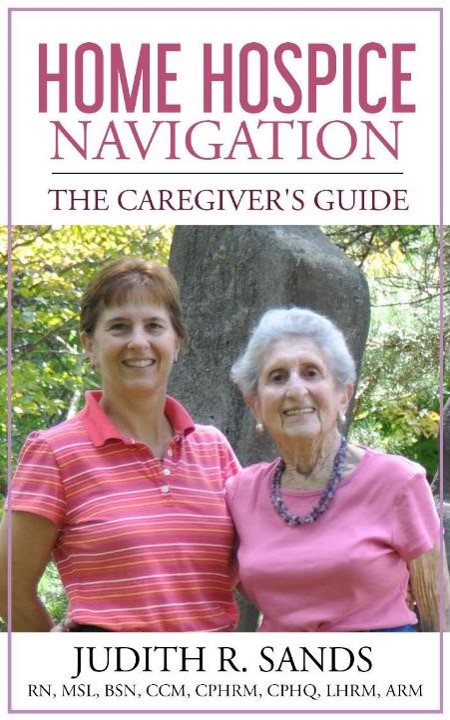In Home Hospice Navigation – The Caregiver’s Guide, author, nurse, caregiver, Judith Sands, focuses on hospice – what it is, the personnel involved, when and how to involve hospice, advance care planning, and more.
After 35 years as a healthcare professional and a family caregiver for her late mom, even Sands faced challenges with home hospice care.
She has written this short book (about 100 pages) to help caregivers navigate end-of-life care.
Many families still don’t understand the critical role hospice plays providing knowledge and comfort to family members.
Judith Sands’ Home Hospice Navigation clarifies the role of hospice along the caregiving continuum and dispels misconceptions about hospice care such as the use of morphine to hasten death. She adds that people can go off of hospice if their condition improves.
Highlights of Home Hospice Navigation
End-of-Life Discussions
We’re all going to die. With advance care planning we can have discussions to ensure our desires are known. Sands offers resources such as Aging with Dignity’s popular Five Wishes, which helps people plan before a health crisis occurs and the Institute for Healthcare Improvement’s Conversation Starter Kit.
Levels of Hospice Care and the Personnel Involved
Readers will learn about the four levels of hospice care and the personnel involved, including the hospice physician, nurse, social worker, CNA, and community volunteer. This is the only book I’ve reviewed so far that takes a realistic view of the costs of 24-hour in-home care. Yes, it can cost more than residential care, but your loved one stays at home.
Shared Caregiving
A week or two ago, I shared what I considered was an original idea with an in-home care provider’s communications director. Here it is in Judith Sands’ book. She calls is shared caregiving. It’s a way to save on expenses by sharing one or two caregivers among several care recipients whose care needs may not be as demanding.
Helpful Hints
- Clear the area to make it easier for family and professionals to provide care.
- Barrier cream to prevent skin irritation.
- Nausea and vomiting due to certain foods and smells.
- Words to provide comfort and ways to handle insensitive remarks.
Considerations
- Dealing with family conflicts.
- Nutritional needs versus family members’ feelings about loss of appetite.
- Medical equipment and supplies provided by hospice.
- Preparing for adversity.
If the power goes out and your loved one needs an oxygen canister to breathe, what to do to arrange (ideally, beforehand) an emergency supply.
The Last Days
She offers a detailed list of what to expect at the end of life a few months before death, one to two weeks, days and/or hours, and even in the final moments.
A glossary makes it easy to refer to important terms dealing with end-of-life care.
Five appendices include a Home Agency Checklist and a Funeral Pricing Checklist.
Be prepared. Don’t get blindsided by a crisis. Pick up a copy of and read Home Hospice Navigation and then review the pages again as needed during end-of-life care.
To learn more, visit JudithSands.com









Very good article that caregivers need to pay attention to. I almost didn’t.
I’m glad you did, Don!